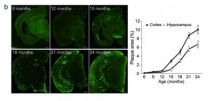(Press-News.org) A study following more than 1,800 children from ages 6 months to nearly 8 years found a small but consistent association between increased television viewing and shorter sleep duration. The presence of a television in the room where a child sleeps also was associated with less sleep, particularly in minority children. Investigators from MassGeneral Hospital for Children (MGHfC) and Harvard School of Public Health (HSPH) report their results – the first to examine the connection between television and sleep duration over several years – in the May issue of Pediatrics.
The study participants, children and their mothers, were enrolled in Project Viva, a long-term investigation of the health effects of several factors during pregnancy and after birth. This study analyzed information – reported by mothers when the children were around 6 months old and then annually for the next seven years – regarding how much time each day infants were in a room where a television was on, how much time older children watched television daily, whether children ages 4 to 7 slept in a room where a TV was present and their child's average daily amount of sleep.
The study revealed that, over the course of the study, each additional hour of television viewing was associated with 7 fewer minutes of sleep daily, with the effects appearing to be stronger in boys than in girls. Racial and ethnic minority children were much more likely to sleep in a room where a television was present, and among those children, the presence of a bedroom television reduced average sleep around a half-hour per day.
The study authors note their results support previous short-term studies finding that both television viewing and sleeping in a room with a television decrease total sleep time, which can have negative effects on both mental and physical health.
INFORMATION:
Elizabeth Cespedes, SM, of the HSPH Department of Nutrition is lead author of the Pediatrics report; and Elsie Taveras, MD, MPH, chief of General Pediatrics at MGHfC is senior author. Additional co-authors are Matthew Gillman, MD, SM, Ken Kleinman, ScD, and Sheryl Rifas-Shiman, MPH, Department of Population Medicine, Harvard Medical School; and Susan Redline, MD, MPH, Brigham and Women's Hospital. Project Viva is supported by the National Institutes of Health and the Centers for Disease Control and Prevention.
Harvard School of Public Health brings together dedicated experts from many disciplines to educate new generations of global health leaders and produce powerful ideas that improve the lives and health of people everywhere. As a community of leading scientists, educators, and students, we work together to take innovative ideas from the laboratory and the classroom to people's lives—not only making scientific breakthroughs, but also working to change individual behaviors, public policies, and health care practices. Each year, more than 400 faculty members at HSPH teach 1,000-plus full-time students from around the world and train thousands more through online and executive education courses. Founded in 1913 as the Harvard-MIT School of Health Officers, the School is recognized as America's oldest professional training program in public health.
Massachusetts General Hospital, founded in 1811, is the original and largest teaching hospital of Harvard Medical School. The MGH conducts the largest hospital-based research program in the United States, with an annual research budget of more than $775 million and major research centers in AIDS, cardiovascular research, cancer, computational and integrative biology, cutaneous biology, human genetics, medical imaging, neurodegenerative disorders, regenerative medicine, reproductive biology, systems biology, transplantation biology and photomedicine.
Study supports detrimental effects of television viewing on sleep in young children
Long-term study confirms association between more television viewing and reduced sleep
2014-04-14
ELSE PRESS RELEASES FROM THIS DATE:
Reduction in HPV in young women in England seen, following national immunization program
2014-04-14
Each year around 2,000-2,500 women are diagnosed with cervical cancer in England, the most common cancer in women under 35. Infection with high-risk human papillomavirus (HR HPV) types 16 and 18 is responsible for around 70-80% of cervical cancers. A study conducted by Public Health England and presented today at the Society for General Microbiology's Annual Conference shows a reduction in these two HR HPV types – which are included in the HPV vaccines used – in sexually active young women in England.
Between 2010 and 2012, over 4000 samples were collected from young ...
Gene linked to pediatric kidney cancer suggests new strategies for kidney regeneration
2014-04-14
BOSTON (April 14, 2014)—Nearly one-third of cases of Wilms tumor, a pediatric cancer of the kidney, are linked to a gene called Lin28, according to research from Boston Children's Hospital. Mice engineered to express Lin28 in their kidneys developed Wilms tumor, which regressed when Lin28 was withdrawn, indicating that strategies aimed at blocking or deactivating the gene hold therapeutic promise for children with Wilms. Studies in the mouse model further suggest that controlled expression of Lin28 can promote kidney development and therefore may hold clues to regeneration ...
Mechanism, and possible treatment, for immune suppression in liver disease uncovered
2014-04-13
The mechanism which underlies the susceptibility of liver disease patients to life-threatening infection has been uncovered by Wellcome Trust-funded medical scientists, who have also suggested a possible treatment to reverse immune suppression in these patients.
Liver disease, or cirrhosis, is currently the fifth leading cause of death in the UK. Cirrhosis patients are more than five times more likely to pick up infections in hospital than patients with other chronic conditions, due to reduced immunity which is a well-recognised feature of the disease.
In a study published ...
How a Silly Putty ingredient could advance stem cell therapies
2014-04-13
ANN ARBOR—The sponginess of the environment where human embryonic stem cells are growing affects the type of specialized cells they eventually become, a University of Michigan study shows.
The researchers coaxed human embryonic stem cells to turn into working spinal cord cells more efficiently by growing the cells on a soft, utrafine carpet made of a key ingredient in Silly Putty. Their study is published online at Nature Materials on April 13.
This research is the first to directly link physical, as opposed to chemical, signals to human embryonic stem cell differentiation. ...
Fish from acidic ocean waters less able to smell predators
2014-04-13
VIDEO:
Scientists collected fish from the coral reefs shown here and found that fish from the more acidic waters of the bubble reefs were less likely to detect the odor of...
Click here for more information.
Fish living on coral reefs where carbon dioxide seeps from the ocean floor were less able to detect predator odor than fish from normal coral reefs, according to a new study.
The study confirms laboratory experiments showing that the behavior of reef fishes can be seriously ...
Hereditary trauma
2014-04-13
The phenomenon has long been known in psychology: traumatic experiences can induce behavioural disorders that are passed down from one generation to the next. It is only recently that scientists have begun to understand the physiological processes underlying hereditary trauma. "There are diseases such as bipolar disorder, that run in families but can't be traced back to a particular gene", explains Isabelle Mansuy, professor at ETH Zurich and the University of Zurich. With her research group at the Brain Research Institute of the University of Zurich, she has been studying ...
Glasses strong as steel: A fast way to find the best
2014-04-13
Scientists at Yale University have devised a dramatically faster way of identifying and characterizing complex alloys known as bulk metallic glasses (BMGs), a versatile type of pliable glass that's stronger than steel.
Using traditional methods, it usually takes a full day to identify a single metal alloy appropriate for making BMGs. The new method allows researchers to screen about 3,000 alloys per day and simultaneously ascertain certain properties, such as melting temperature and malleability.
"Instead of fishing with a single hook, we're throwing a big net," said ...
Virus-fighting genes linked to mutations in cancer
2014-04-13
Researchers have found a major piece of genetic evidence that confirms the role of a group of virus-fighting genes in cancer development.
Our understanding of the biological processes that cause cancer is limited. UV light and smoking are two well-understood cancer-causing processes. Exposure to either of these processes causes distinguishable patterns of genetic damage, or 'signatures', on the genome that can lead to cancer. All cancer-causing processes leave their own distinct imprint or signature, on the genomes of cancer cells.
The APOBEC family of genes control ...
Tiny particles could help verify goods
2014-04-13
CAMBRIDGE, MA -- Some 2 to 5 percent of all international trade involves counterfeit goods, according to a 2013 United Nations report. These illicit products — which include electronics, automotive and aircraft parts, pharmaceuticals, and food — can pose safety risks and cost governments and private companies hundreds of billions of dollars annually.
Many strategies have been developed to try to label legitimate products and prevent illegal trade — but these tags are often too easy to fake, are unreliable, or cost too much to implement, according to MIT researchers who ...
New mouse model could revolutionize research in Alzheimer's disease
2014-04-13
Alzheimer's disease, the primary cause of dementia in the elderly, imposes a tremendous social and economic burden on modern society. In Japan, the burden of the disease in 2050 is estimated to be a half a trillion US dollars, a figure equivalent to the government's annual revenues.
Unfortunately, it has proven very difficult to develop drugs capable of ameliorating the disease. After a tremendous burst of progress in the 1990s, the pace of discoveries has slowed. Dr. Saido believes that part of the difficulty is the inadequacy of current mouse models to replicate the ...
LAST 30 PRESS RELEASES:
Deep neural networks enable accurate pricing of American options under stochastic volatility
Collective risk resonance in Chinese stock sectors uncovered through higher-order network analysis
Does CPU impact systemic risk contributions of Chinese sectors? Evidence from mixed frequency methods with asymmetric tail long memory
General intelligence framework to predict virus adaptation based on a genome language model
Antibiotic resistance is ancient, ecological, and deeply connected to human activity, new review shows
Vapes, pouches, heated tobacco, shisha, cigarettes: nicotine in all forms is toxic to the heart and blood vessels
From powder to planet: University of Modena engineers forge a low-carbon future for advanced metal manufacturing
Super strain-resistant superconductors
Pre-school health programme does not improve children’s diet or physical activity, prompting call for policy changes, study finds
Autumn clock change linked to reduction in certain health conditions
AI images of doctors can exaggerate and reinforce existing stereotypes
Where medicine meets melody – how lullabies help babies and parents in intensive care
We may never be able to tell if AI becomes conscious, argues philosopher
AI video translation shows promise but humans still hold the edge
Deep ocean earthquakes drive Southern Ocean’s massive phytoplankton blooms, study finds
Without campus leftovers to pick through, the beaks of this bird changed shape during the pandemic
High-dose antibiotic does not reduce mortality in tuberculous meningitis
How many insects fly in the sky above the USA?
Could cheese protect your brain health?
Who faces more difficulty recovering from stroke?
Colliding galaxies create the brightest, fastest growing black holes at their center
New BrainHealth research reveals tradeoffs on sleep with cannabis use for chronic pain
Aging-US now on ResearchGate, enhancing visibility for authors and readers
'Molecular glue' stabilizes protein that inhibits development of non-small cell lung cancer
Mount Sinai Health System is recognized in 2025 Chime Digital Health Most Wired survey
From prey to predator: How carnivores spread beneficial fungi
Menopause symptoms may be frequent and have negative effects, according to female endurance athletes
US Congressmembers’ responses on X to mass shooting events differ along party lines
KAIST-UEL team develops “origami” airless wheel to explore lunar caves
Individual genetic differences render some therapies ineffective
[Press-News.org] Study supports detrimental effects of television viewing on sleep in young childrenLong-term study confirms association between more television viewing and reduced sleep



